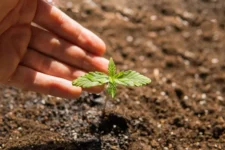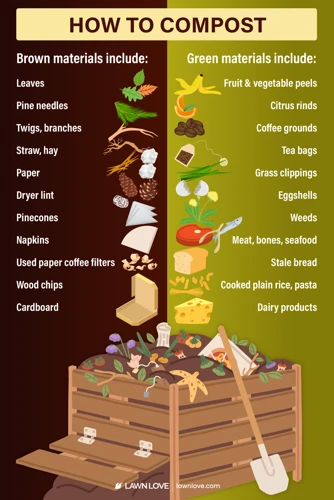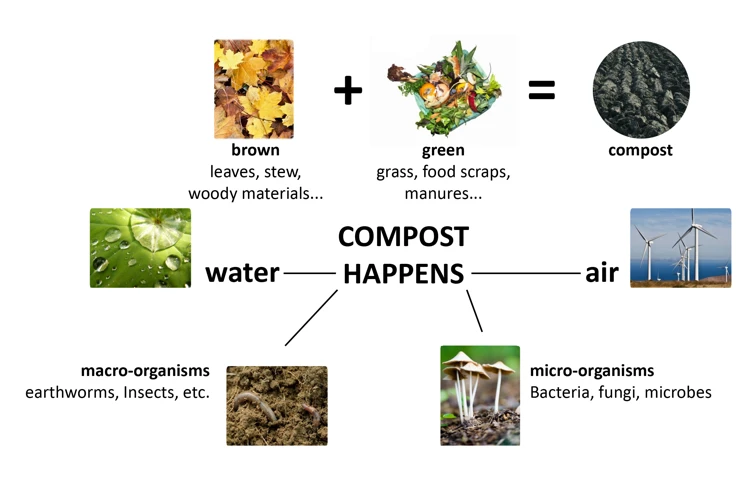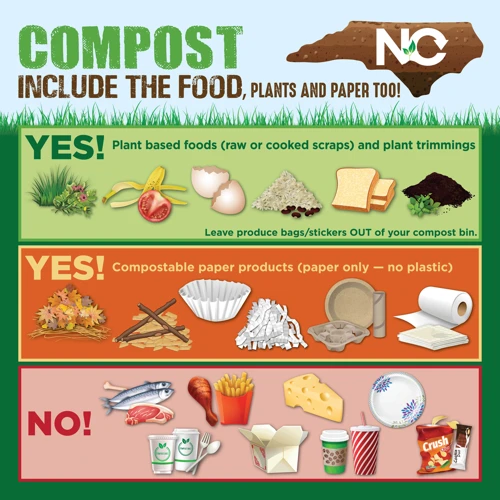
Cannabis Composting 101: A Beginner’s Guide
Growing cannabis is a rewarding and fulfilling experience, but it requires more than simply planting and watering the seeds. One of the most important aspects of cannabis cultivation is soil health. Without healthy soil, your cannabis plants won’t thrive. Composting is an excellent way to improve soil health and provide your cannabis plants with the nutrients they need to grow strong and healthy. However, composting can seem complicated and overwhelming, especially for beginners. In this article, we will explore the basics of composting for cannabis growing, from the science behind it to the step-by-step process of creating and using compost. So let’s dive in and learn how to create nutrient-rich compost that will help your cannabis plants reach their full potential.
What is Composting?
Contents
When it comes to cannabis growing, one of the best things you can do for your plants is to provide them with nutrient-rich soil. Composting is an excellent way to create your own organic fertilizer that will help your plants thrive. But what exactly is composting? Essentially, it’s the process of decomposing organic matter to create a nutrient-rich soil amendment. Through this natural process, you’ll be able to enrich your soil with beneficial microorganisms and nutrients that will provide your cannabis plants with everything they need to grow and thrive.
The Science of Composting
Composting is a natural process of biological decomposition, which relies on microorganisms like bacteria and fungi to break down organic matter into nutrient-rich soil. Understanding the science behind composting is essential to creating a successful compost pile for your cannabis grow. Here are a few scientific concepts to consider:
- Carbon:Nitrogen Ratio – A compost pile must have the right balance of carbon-rich materials (known as brown waste) and nitrogen-rich materials (known as green waste). The ideal carbon:nitrogen ratio for composting is between 20:1 to 30:1. Carbon materials include dried leaves, wood chips or sawdust, while nitrogen sources include food scraps, grass clippings and manure.
- Aerobic vs. Anaerobic Bacteria – Aerobic bacteria require oxygen to survive and are responsible for breaking down compost materials quickly while minimizing odors. In contrast, anaerobic bacteria work without oxygen and create unpleasant smells. To promote aerobic bacteria in your compost pile, turn or aerate it regularly to ensure oxygen levels stay high.
- Temperature – The temperature of a compost pile can be an indicator of the decomposition process. Ideally, you want the pile to heat up between 120-160°F (49-71°C) in the first few days, indicating that the bacteria are breaking down the materials efficiently. After a few weeks, the temperature will begin to decrease as the compost becomes more stable.
- Moisture – Microorganisms and bacteria require moisture to survive and thrive, so keep your compost pile moist, but not too wet. If the compost is too dry, microorganisms cannot break down the materials quickly, whereas too much moisture can lead to anaerobic conditions and bad smells. A moisture level between 40-60% is ideal.
By understanding how these scientific concepts interconnect and influence composting, you can create a thriving compost pile that will provide your cannabis plants with the necessary nutrients and optimal growing conditions.
Benefits of Composting for Cannabis
Composting is a simple yet effective way to feed and nourish cannabis plants while also contributing to a sustainable ecosystem. The benefits of composting go beyond just providing nutrient-rich soil for our plants. Here are some key benefits of composting for cannabis:
| Benefit | Description |
|---|---|
| Better Soil Structure | Composting helps to create soil with a better balance of porosity and water retention, which is ideal for cannabis roots to grow and flourish. |
| Improved Soil pH Levels | Using compost can help to balance soil pH levels, creating an environment that allows cannabis plants to more easily absorb nutrients and thrive. |
| Increased Microbial Activity | Composting encourages the growth and proliferation of beneficial microbes, which support the ecosystem of the soil and prevent the growth of harmful pathogens. |
| Reduction in Waste | Composting offers an environmentally friendly solution for disposing of organic waste, reducing greenhouse gas emissions and lowering landfill use. |
| Cost-Effective | Composting can be a cost-effective alternative to purchasing expensive fertilizers and soil amendments, as it can be produced at home with minimal investment. |
| Increased Yield and Quality | By providing cannabis plants with nutrient-rich soil, composting can lead to increased yield and improved quality of the final product. |
It’s important to note that composting takes time and effort, but the benefits make it worth investing in. Plus, once you get the hang of it, composting can become an easy and satisfying part of your cannabis growing routine.
Composting Essentials
When it comes to composting, there are a few essential things you need to know before getting started. From choosing the right container to creating the perfect mix of organic matter, it can be overwhelming to figure out where to begin. But don’t worry, we’ll break down the basics of composting for cannabis growing so that you can easily create a nutrient-rich soil amendment for your plants to thrive in. So let’s dive in and learn about the composting essentials!
Choosing the Right Container
When it comes to composting, choosing the right container can make all the difference. There are a few important things to consider when selecting a container for your compost.
Firstly, you’ll want to consider the size of the container. It should be large enough to hold all of your compost materials, but not so large that it becomes difficult to turn or manage. A good rule of thumb is to choose a container that’s at least 3 feet by 3 feet.
Next, you’ll want to think about the material of the container. You can use a variety of materials, including plastic, metal, or wood. Plastic containers are lightweight and hold moisture well, but may not be as durable as other materials. Metal containers are sturdy, but may rust over time. Wood containers are attractive and blend in well with outdoor landscapes, but may need to be replaced after a few years.
In addition to size and material, you’ll want to consider the shape of the container. A square or rectangular container will allow for easy turning and mixing of your compost materials. If you choose a round container, make sure it has a lid and is easy to access for turning and adding materials.
Finally, you’ll want to think about aeration. Your compost needs oxygen to break down properly, so it’s important to choose a container with good ventilation. Look for a container with plenty of holes or slots to allow for air flow. If you’re using a closed container, make sure to turn and mix your compost regularly to keep it aerated.
Here’s a helpful table summarizing the factors to consider when choosing a compost container:
| Factor | Considerations |
|---|---|
| Size | At least 3 feet by 3 feet |
| Material | Plastic, metal, or wood |
| Shape | Square or rectangular for easy turning |
| Aeration | Good ventilation and regular turning/mixing |
Creating the Right Mix
To create the right mix for composting, you need the perfect blend of “greens” and “browns”.
“Greens” are materials that are high in nitrogen, such as grass clippings, plant trimmings, and kitchen scraps like fruit and vegetable peels.
“Browns”, on the other hand, are high in carbon and include dry leaves, straw, and wood chips.
The ideal ratio of greens to browns is 1:2. This helps to balance the carbon-to-nitrogen ratio and creates an environment in which beneficial microbes can break down the organic material.
Here are some examples of green and brown compost materials:
- Greens: grass clippings, kitchen scraps, coffee grounds, tea leaves, and fresh plant trimmings.
- Browns: dry leaves, sawdust, straw, hay, and shredded newspaper.
It’s important to note that some materials should not be used in composting, as they can attract pests or contain harmful chemicals. Avoid composting meat, dairy, or oily foods, as well as pet waste or diseased plants.
Once you have the right mix of compost materials, it’s time to begin the composting process.
What to Compost and What Not to Compost
When it comes to composting for cannabis growing, it’s important to know what materials you should and shouldn’t compost. Composting requires a balance, and adding the wrong items to your compost pile can disrupt that balance and hinder the process.
Here’s a table outlining what to compost and what not to compost:
| What to Compost | What Not to Compost |
|---|---|
| Food scraps (fruit and vegetable peelings, eggshells, coffee grounds, tea bags) | Meat, dairy, and oily foods (can attract pests or take a long time to break down) |
| Yard waste (grass clippings, leaves, plant trimmings) | Plastic, metal, or glass (these materials cannot break down and will contaminate the compost) |
| Paper and cardboard (shredded newspaper, cardboard boxes) | Concerned soil or anything with chemicals (can kill beneficial microbes in the compost) |
| Manure from herbivores (cow, horse, chicken, etc.) | Manure from carnivores (cat, dog, etc.) |
| Wood chips and sawdust (in moderation) | Large branches or logs (take a long time to break down) |
It’s important to note that while some materials may be compostable, they may not be suitable for composting for cannabis growing. For example, some food scraps like onions and garlic can change the flavor of the soil, while adding too much wood chips can make the soil too acidic. Always do your research and experiment to see what works best for your compost pile and cannabis plants.
How to Keep Your Compost Pile Balanced
Keeping your compost pile balanced is essential to ensure the successful breakdown of organic materials into nutrient-rich compost for your cannabis plants. Here are some tips on how to achieve a balanced compost pile:
| Ingredient | Amount | Purpose |
|---|---|---|
| Brown materials (dry leaves, straw, etc.) | 2-3 parts | Provide carbon for energy |
| Green materials (fruit and veggie scraps, grass clippings, etc.) | 1 part | Provide nitrogen for growth and reproduction |
| Water | As needed | Ensure proper moisture level for decomposition |
| Air | N/A | Allow aerobic bacteria to thrive |
It’s essential to maintain a roughly 2:1 ratio of brown materials to green materials in your compost pile to ensure proper balance. You can also add water as needed to maintain proper moisture levels. Turning the compost pile regularly can help provide adequate aeration for the bacteria to thrive and break down the materials.
Another way to boost your compost pile’s balance is by adding amendments such as bone meal or blood meal. These ingredients can provide additional nitrogen and help speed up the composting process. However, be cautious not to add too much at once, as this can create an imbalance in the compost pile.
By following these tips, you can keep your compost pile balanced and ensure the creation of nutrient-rich compost that is perfect for your cannabis plants.
Creating Your Compost
Now that you have all the necessary knowledge about composting for cannabis, it’s time to put that knowledge into practice by creating your own compost. This may seem daunting at first, but fear not, as we are here to guide you through each step of the process. In this section, we will provide you with a detailed, step-by-step guide to creating compost that is perfect for growing healthy, thriving cannabis plants. Whether you are a seasoned gardener or a new cannabis grower, this guide will equip you with everything you need to create your own compost that is rich in nutrients and beneficial microorganisms. So let’s dive in and start creating your very own compost pile!
Step-by-Step Guide to Composting for Cannabis
Step-by-Step Guide to Composting for Cannabis:
| Step 1: | Choose the right location for your compost pile. It should be in a sunny, well-drained area that’s easily accessible. |
| Step 2: | Select an appropriate compost container. Options include a compost bin, a compost tumbler, or a simple pile. |
| Step 3: | Gather your organic materials. These include “browns” such as dried leaves, straw, and sawdust, as well as “greens” such as vegetable scraps, grass clippings, and coffee grounds. Aim for a carbon-to-nitrogen ratio of about 30:1. |
| Step 4: | Layer your organic materials in the compost container. Start with a layer of browns, then add a layer of greens, and continue layering until the container is almost full. |
| Step 5: | Add water to your compost pile. It should be moist, but not soaking wet. Use a hose or watering can to add water as needed. |
| Step 6: | Cover your compost pile to retain moisture and warmth. Use a tarp or a lid if you’re using a bin or tumbler. |
| Step 7: | Turn your compost pile regularly to aerate it and speed up decomposition. Use a pitchfork or a compost aerator to mix up the materials and expose them to oxygen. |
| Step 8: | Monitor your compost pile’s temperature and moisture level. It should reach a temperature of 130-150 degrees Fahrenheit to kill off weed seeds and harmful bacteria. If it’s too dry, add water; if it’s too wet, add more browns. |
| Step 9: | Wait for your compost to finish. It should take between 2-6 months depending on the size of the pile and the materials used. It will be ready when it’s crumbly and dark, with a pleasant earthy smell. |
By following these steps, you can create a nutrient-rich compost that’s perfect for your cannabis plants. It’s a great way to recycle organic waste and reduce your environmental impact while also saving money on expensive fertilizers. Just remember to be patient, monitor your compost pile regularly, and enjoy the benefits of this sustainable gardening practice.
Alternative Composting Methods
If traditional composting methods are not an option for you, don’t worry – there are alternative methods that you can use to create nutrient-rich compost for your cannabis plants. Here are some options:
- Vermicomposting: This method involves using worms to help break down organic matter. Worms such as red wigglers and earthworms are added to a container with bedding material and food scraps. They consume the scraps, and their waste (aka worm castings) makes excellent compost for cannabis plants. This method requires less space and is quicker than traditional composting, but it requires the right conditions for the worms and may produce less compost overall.
- Bokashi: Bokashi is a method that involves using a special mix of microorganisms to ferment organic matter in an airtight container. This process does not create compost in the traditional sense, but rather a pre-compost that is then buried in soil to further break down over time. The fermented material adds beneficial microbes to the soil and can be used as a soil amendment for cannabis plants. Bokashi is a good option for those with limited space and time, but the initial cost of the microorganisms may be higher.
- Green Manure: Green manure involves planting cover crops (often legumes) that are then tilled into the soil to add organic matter and nutrients. This method can be done in between cannabis grows to help prepare the soil for the next crop. It is a low-cost option that also helps prevent soil erosion and suppresses weeds. However, it takes longer to see the benefits compared to traditional composting.
No matter which composting method you choose, the end result will be nutrient-rich compost that can help your cannabis plants thrive. Consider your space, time, and budget when deciding which method to use.
Using Compost for Cannabis Growing
Now that you have successfully created your compost, it’s time to put it to use in your cannabis growing process. Incorporating compost into your growing routine has tremendous benefits for your plants and the environment. From improving soil structure to enhancing nutrient availability, using compost is a sustainable and cost-effective way to ensure healthy cannabis growth. In this section, we will explore how to properly apply compost to your growing operation, as well as troubleshooting any issues that may arise. So, let’s dive into the world of using compost for cannabis growing!
How to Apply Compost
Applying compost to your cannabis plants can boost their growth and health significantly. To ensure proper application of compost, it is necessary to follow some simple steps.
Step 1: Before applying compost, ensure that it is fully matured and broken down. Mature compost should appear dark brown or black, crumbly and have an earthy smell.
Step 2: Apply a layer of compost around your cannabis plants, ensuring that the compost does not touch the plant stems. A layer that’s around 1-2 inches thick is recommended.
Step 3: Gently mix the compost layer into the topsoil with a fork or trowel. Be careful not to disturb the plant roots.
Step 4: Water the soil well to help the compost settle in and release its nutrients into the soil.
Step 5: Repeat this process once or twice a year, depending on your cannabis plant’s needs. It’s recommended to apply compost during the early stages of growth and again during the flowering stage.
When applying compost, it’s important to avoid making direct contact with the plant stem, as this can cause rot or disease. Also, it’s not recommended to apply compost in excessive amounts, as this can lead to nutrient imbalances and other issues.
Composting is an excellent way to provide your cannabis plants with the essential nutrients they need while also reducing waste. Proper application of compost can provide your plants with the necessary elements required for healthy growth and a robust yield.
Composting Troubleshooting
When composting, it’s not uncommon to run into issues that can slow down or even halt the process altogether. Here are some common troubleshooting tips to help you get your compost pile back on track:
- Too Wet: If your compost is too wet, it can start to smell and attract pests. To remedy this, add more dry/brown materials like leaves or shredded paper, and turn the pile more frequently to increase aeration and evaporation.
- Too Dry: A compost pile that is too dry won’t decompose properly. To fix this, add more moisture by watering the pile thoroughly or adding wet/green materials like kitchen scraps or grass clippings.
- Not Decomposing: If your compost isn’t breaking down, it may not have enough nitrogen-rich/green materials. Try adding more food scraps or grass clippings to the pile and turn it more frequently to improve oxygen flow.
- Foul Odors: If your compost pile is emitting a foul odor, it may be too wet or lack enough oxygen. Turn the pile more frequently and add more dry/brown materials to improve aeration and reduce moisture.
- Pest Infestations: Compost piles can attract pests like rodents, flies, and ants if they contain too much food waste. To prevent this, bury food waste under brown materials and avoid adding too much meat, dairy, or oils.
By troubleshooting these common issues and making adjustments to your compost pile, you can create nutrient-rich soil that’s perfect for growing your own cannabis plants.
Conclusion
In conclusion, composting is a great way to not only reduce waste but also provide your cannabis plants with the valuable nutrients they need to thrive. By understanding the science of composting and the benefits it provides, you can create high-quality organic fertilizers that will improve your soil health and increase your plant growth.
When starting your compost pile, it’s important to choose the right container and create the right mix of ingredients. While adding any organic material to your pile is encouraged, it’s important to remember what you should and shouldn’t compost to keep your pile balanced. By following a step-by-step guide to composting for cannabis, you can easily create and maintain a healthy pile that provides your plants with the essential nutrients they need.
Once your compost is ready, using it for your cannabis growing is easy. Applying compost to your soil will enrich it with beneficial microbes, improve soil structure, and increase water retention. However, it’s important to understand composting troubleshooting to avoid any negative effects on your plants.
In summary, composting is a valuable tool for any cannabis grower looking to improve their plant growth and reduce waste. By following the basics of composting, you can create a sustainable fertilizer source that will benefit not only your plants but also the environment.
Frequently Asked Questions
What materials can be used for composting?
A variety of organic materials can be used for composting, including plant matter like leaves and grass clippings, food scraps like fruits and vegetables, coffee grounds and filters, as well as eggshells and paper products.
Can animal waste be used for composting?
Yes, manure from herbivores like cows, horses, and rabbits can be used for composting, but it needs to be aged for at least six months before use to avoid the risk of harmful bacteria. Avoid using pet waste as it could contain pathogens harmful to humans.
How long does the composting process take?
The composting process can take anywhere from a few months to a year, depending on the materials used, the size of the compost pile, and the environmental conditions such as temperature and moisture.
What is the ideal temperature for composting?
The ideal temperature range for composting is between 130°F and 160°F. At these temperatures, the microorganisms responsible for breaking down the organic materials are most active, leading to a faster composting process.
Do I need to turn my compost pile?
Yes, turning the compost pile regularly helps to ensure proper aeration and mixing of the materials, which is essential for successful composting. However, there are alternative methods that don’t require manual turning.
Can compost be used as a soil amendment?
Yes, compost is an excellent soil amendment that can improve soil structure, fertility, and water-holding capacity. It also provides essential nutrients for plant growth and can help suppress plant diseases.
What are some common composting mistakes?
Common composting mistakes include adding too much of one material, neglecting to turn or air out the compost pile, not keeping the pile moist enough, and adding materials that cannot be composted.
Can compost be made in a small space?
Yes, compost can be made in a small space using a compost bin or tumbler. Indoor composting methods like worm composting are also an option for those with limited outdoor space.
How do I know when my compost is ready to use?
Compost is ready to use when it has turned into a dark, crumbly soil-like substance and no longer resembles the original materials. It should have a pleasant earthy smell and be free of any large chunks or uncomposted materials.
Is composting environmentally friendly?
Yes, composting is environmentally friendly as it helps divert organic waste from landfills, reduces greenhouse gas emissions, and provides an all-natural fertilizer and soil amendment that supports sustainable gardening practices.





